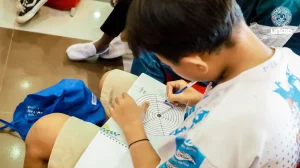Universal access to proper sanitation and hygiene is one of the Sustainable Development Goals (SDGs) that need to be achieved by 2030. They include the end of open defecation. Therefore, special attention must be given, especially to women and people who have vulnerable situations.
Access to sanitation for all Indonesians has been included in the 2014-2019 National Long-Term Development Plan (RPJMN). Unfortunately, there have not been significant changes in Indonesia in the reform era. Based on World Bank research, families without adequate sanitation facilities in Indonesia dump 6.4 million tons of human waste into rivers every year.
One way to achieve universal access to sanitation is to increase the number of Communal Wastewater Treatment Plants (IPAL) and their service areas. The goal is simple, to provide sanitation facilities for the community so that they stop defecating in the open. However, even though this facility has already been built, the Communal IPAL is not functioning correctly because the wastewater processing is not monitored accurately.
Some wastewater treatment technologies commonly used are Anaerobic Baffled Reactor (ABR) and Anaerobic Filter (AF). ABR is a septic tank that consists of several partition walls that make wastewater flow along the path made by the wall, so ABR has a longer storage time than an ordinary septic tank. It can also enhance biological processes for breaking down waste while AF is a media that attaches anaerobic bacteria that functions to break down pollutants in waste. So, when wastewater flows through the septic tank attached to this media, the pollution will decrease.
To find out whether the IPAL is working well, a study in Gresik District was conducted. Research data was taken from domestic wastewater samples and questionnaires. This questionnaire was filled out by KPP as the manager of Communal IPAL in 7 areas in Gresik Regency. This questionnaire was given to analyze the behavior, beliefs, and characteristics of the community in a particular environment.
The technology used at the Communal IPAL is a combination of ABR and AF. Physically, all Communal IPALs in the study area are in good condition. However, the wastewater that has been treated by IPAL smells terrible. It was caused by insufficient ventilation. Domestic wastewater has a high protein content. The process of decomposing proteins in waste is the main source of the odor. According to 41.30% of respondents, the main problem with the wastewater distribution system is the blockage.
Furthermore, Singosari 1, Bedilan, and Roomo wastewater treatment facilities had high concentrations of oil, fat, and organic matter. Because of the high organic matter content, Biochemical Oxygen Demand (BOD) and Chemical Oxygen Demand (COD) were also high. It showed that the biological decomposition process in the Communal wastewater treatment plant is not going well. Research also showed that there was excessive use of detergents, which causes groundwater to have a high hardness level.
According to the results of the study, all Communal IPAL have a high level of BOD removal efficiency, but only IPAL Roomo met the COD removal efficiency standards. BOD and COD ratios are used to determine the ability of waste to undergo biodegradation or the breakdown of organic pollutants by microbial activity. The ratio of Communal IPAL BOD and COD studied showed that untreated wastewater could be processed biologically with the help of microbes.
Sanitation objectives have not been achieved due to lack of maintenance by the User Maintenance Group (KPP). Maintenance of IPAL is needed to maintain the life of the installation. The tasks of the KPP are to prepare the mechanism of work, operational, and maintenance of IPAL as well as the distribution of wastewater, collect contribution funds for operational and maintenance costs, operate and maintain IPAL including the sewer system, improve the quality of services, and carry out health campaigns. However, based on the survey, the level of understanding of KPP’s duties was still low.
Furthermore, KPP has not been much involved in the management of IPAL. The wastewater treatment plant is only monitored once a year by government agencies, and according to the SOP, it should be carried out by the KPP.
Overall, the Communal IPALs in the study area were quite good, but the main problem in each IPAL was the smell. KPP did not quite understand its duties and responsibilities.
Author: Nurina Fitriani
Here is a scientific journal link from the text:
http://penerbit.uthm.edu.my/ojs/index.php/ijie/article/view/4269
References
Soedjono, E. S., Fitriani, N., Setiawan, A., Mulia, G. J., & Ningsih, D. A. (2019). Study on Communal Wastewater Treatment Plants (CWWTPs) in Gresik, Indonesia. International Journal of Integrated Engineering, 236-242.









